 |
Convert 3GPP to AMR
|
Total Audio MP3 Converter converts 3GPP files to AMR format.
The software is an all in one audio converter that supports more than 90 audio
and video files as input, and converts to popular formats such as MP3, WAV, AAC,
M4A, OGG, WMA, and AMR.
Total Audio MP3 Converter also supports batch conversion, and is full compatible
with Vista and Windows
7.
- Free Download
Total Audio MP3 Converter here and then install the software
by instructions
- Launch Total Audio MP3 Converter
- Choose 3GPP Files
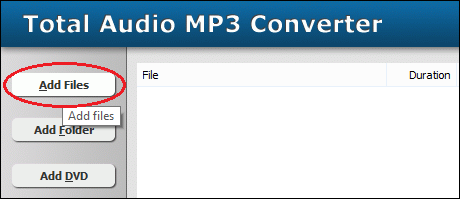
Click "Add Files" to choose 3GPP files and then add them to conversion
list.
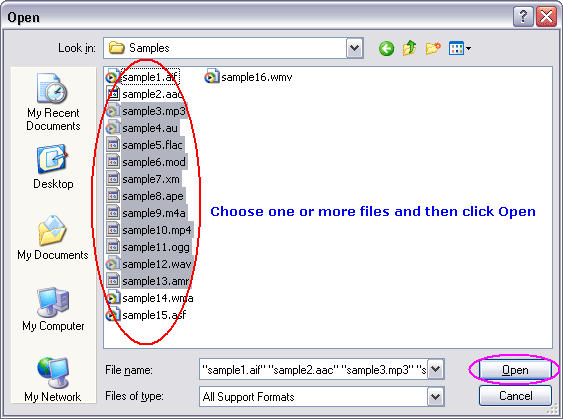
Choose one or more 3GPP files you want to convert and then click Open.
- Choose "to AMR"
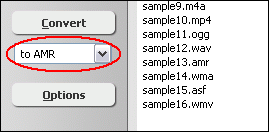
- Convert 3GPP to AMR

Click button "Convert" to convert all 3GPP files to AMR format.
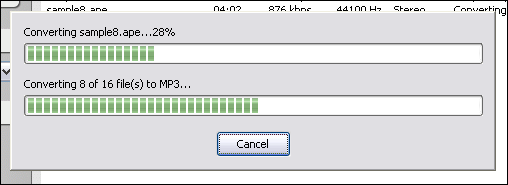
The software is converting 3GPP files to AMR format.
- Play & Browse
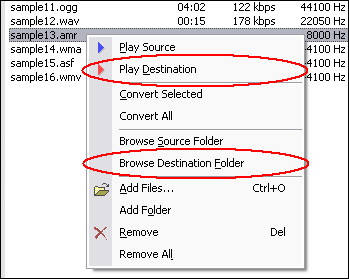
When conversion completes, you could right-click converted item and choose "Play
Destination" to play the destination file; or choose "Browse Destination
Folder" to open Windows Explorer to browse the destination file.
Top
What is 3GPP?
3GP (3GPP file format) is a multimedia container format defined by the Third Generation
Partnership Project (3GPP) for 3G UMTS multimedia services. It is used on 3G mobile
phones but can also be played on some 2G and 4G phones.
3GP is defined in ETSI 3GPP technical specification. 3GP is required file format
for video and associated speech/audio media types and timed text in ETSI 3GPP
technical specifications for IP Multimedia Subsystem (IMS), Multimedia Messaging
Service (MMS) and Transparent end-to-end Packet-switched Streaming Service (PSS).
The 3GP file format stores video streams as MPEG-4 Part 2 or H.263 or MPEG-4
Part 10 (AVC/H.264), and audio streams as AMR-NB, AMR-WB, AMR-WB+, AAC-LC, HE-AAC
v1 or Enhanced aacPlus (HE-AAC v2). 3GPP allowed use of AMR and H.263 codecs in
the ISO base media file format (MPEG-4 Part 12), because 3GPP specified the usage
of the Sample Entry and template fields in the ISO base media file format as well
as defining new boxes to which codecs refer. These extensions was registered by
the registration authority for code-points in ISO base media file format ("MP4
Family" files). For the storage of MPEG-4 media specific information in 3GP
files, the 3GP specification refers to MP4 and the AVC file format, which are
also based on the ISO base media file format. The MP4 and the AVC file format
specifications described usage of MPEG-4 content in the ISO base media file format.
What is AMR?
Adaptive Multi-Rate (AMR) is an audio data compression scheme optimized for speech
coding. AMR was adopted as the standard speech codec by 3GPP in October 1998 and
is now widely used in GSM and UMTS. It uses link adaptation to select from one
of eight different bit rates based on link conditions. AMR is also a file format
for storing spoken audio using the AMR codec. Many modern mobile telephone handsets
will allow you to store short recordings in the AMR format. There also exists
another storage format for AMR that is suitable for applications with more advanced
demands on the storage format, like random access or synchronization with video.
This format is the 3GPP-specified 3GP container format based on ISO base media
file format.
Key Features:
- Sampling frequency 8 kHz/13-bit (160 samples for 20 ms frames), filtered to
200-3400 Hz.
- The AMR codec uses eight source codecs with bit-rates of 12.2, 10.2, 7.95,
7.40, 6.70, 5.90, 5.15 and 4.75 kbit/s.
- Generates frame length of 95, 103, 118, 134, 148, 159, 204, or 244 bits for
bit rates 4.75, 5.15, 5.90, 6.70, 7.40, 7.95, 10.2, or 12.2 kbit/s, respectively
- AMR utilizes Discontinuous Transmission (DTX), with Voice Activity Detection
(VAD) and Comfort Noise Generation (CNG) to reduce bandwidth usage during silence
periods
- Algorithmic delay is 20 ms per frame. For bit-rates of 12.2, there is no 'algorithm'
look-ahead delay. For other rates, look-ahead delay is 5 ms. Note that there is
5 ms 'dummy' look-ahead delay, to allow seamless frame-wise mode switching with
the rest of rates.
- AMR is a hybrid speech coder which uses Algebraic Code Excited Linear Prediction
(ACELP)
- The complexity of the algorithm is rated at 5, using a relative scale where
G.711 is 1 and G.729a is 15.
- PSQM testing under ideal conditions yields Mean Opinion Scores of 4.14 for
AMR (12.2 kbit/s), compared to 4.45 for G.711 (u-law)
- PSQM testing under network stress yields Mean Opinion Scores of 3.79 for AMR
(12.2 kbit/s), compared to 4.13 for G.711 (u-law)
Convert 3GPP to AMR Related Topics:
DXA to AMR,
AMR to M4B,
AMR to M4A,
DIVX to AMR,
AMR to AAC,
MP1 to AMR,
XA to AMR,
NSA to AMR,
OGV to AMR,
MP4 to AMR,
MPE to AMR,
MLP to AMR,
3G2 to AMR,
CD to AMR,
3GPP to AMR,
VMD to AMR,
MOD to AMR,
MPGA to AMR,
SPX to AMR,
DV to AMR,
DVD to AMR,
M4V to AMR,
VOB to AMR,
NUT to AMR,
MP2 to AMR,
OGX to AMR,
NUV to AMR,
VFW to AMR,
SMK to AMR,
M2A to AMR,
FLIC to AMR,
GSM to AMR,
VCD to AMR,
AAC to AMR,
OGM to AMR,
AU to AMR,
DIF to AMR,
GXF to AMR,
AMR Converter,
CDA to AMR
|






